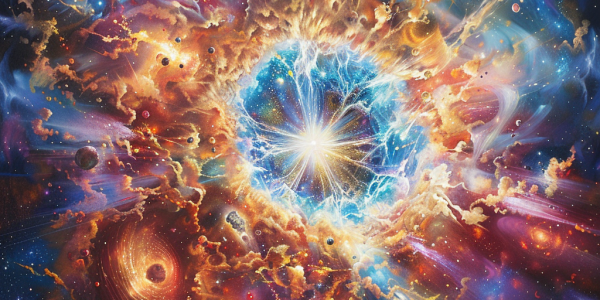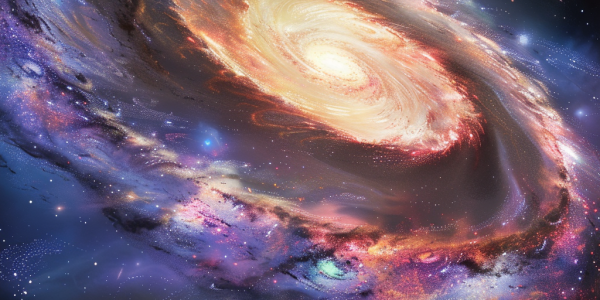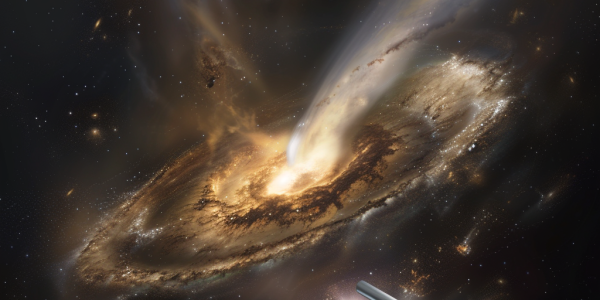Astrophysicists Measure Temperatures in Neutron Star Collision, Unveiling Heavy Element Origins
Astrophysicists at the Niels Bohr Institute have made a groundbreaking discovery by measuring the temperature of elementary particles from neutron star collisions, leading to the formation of the smallest black hole ever recorded. This research, published in Astronomy & Astrophysics, reveals critical insights into the creation of heavy elements like gold and platinum, highlighting the significance of neutron star mergers in the cosmic landscape. The study emphasizes the importance of global collaboration among observatories in unraveling the mysteries of the universe’s most violent events.
Astronomers Discover Massive Black Hole Near Earth in Omega Centauri
Researchers have discovered a new black hole in the Omega Centauri star cluster, located just 18,000 light-years from Earth. This massive black hole, estimated to be 20,000 to 50,000 times the mass of the sun, opens new avenues for astronomical research and enhances our understanding of cosmic evolution. Led by Dr. Holger Baumgardt, the team utilized Hubble Space Telescope images to confirm its existence, highlighting the dynamic nature of our universe and the importance of ongoing exploration in space science.
Navigating Digital Privacy: Understanding Cookies and Data Management
In today’s digital age, understanding privacy choices is crucial as websites utilize essential and optional cookies for functionality and personalization. A recent study using the James Webb Space Telescope reveals new insights into early black hole formation, emphasizing the intersection of data privacy and scientific discovery.
NASA’s Chandra Observatory Reveals New Insights on Black Hole Jets
NASA’s Chandra X-ray Observatory has made groundbreaking discoveries about the jets from the supermassive black hole in the Centaurus A galaxy, revealing particles moving at nearly the speed of light. This research enhances our understanding of black holes and their jets, showcasing a novel approach to studying these cosmic phenomena. With advanced observational techniques, scientists are poised to uncover more about the mysteries of black holes and their role in galaxy evolution.
Navigating Privacy Choices and Cosmic Discoveries: Insights from V404 Cygni
Explore the dual themes of personal privacy in the digital age and the fascinating discoveries surrounding the black hole V404 Cygni. Learn how cookies impact your online experience and the latest insights into cosmic phenomena, including the dynamics of low-mass X-ray binaries and the significance of natal kicks in black hole formation.
Hubble Reveals Supermassive Black Hole Jets Triggering Stellar Eruptions in M87 Galaxy
Astronomers using the Hubble Space Telescope have discovered that jets from the supermassive black hole in the M87 galaxy trigger explosive stellar eruptions, known as novae, in nearby stars. This finding sheds light on the complex interactions between black holes and their cosmic environments, highlighting the significant role of black hole jets in influencing star formation and evolution across the universe.
Discovery of ‘Missing Link’ Black Hole in Binary System G3425
A groundbreaking discovery of a stellar-mass black hole in the binary system G3425, located 5,800 light-years from Earth, has excited astronomers. This ‘missing link’ black hole, with a mass between 3.1 and 4.4 solar masses, challenges existing theories on black hole formation and evolution. The findings, published in Nature Astronomy, highlight the unique interplay between the red giant star and its dark companion, paving the way for further exploration of cosmic phenomena.
XRISM Mission Unveils Groundbreaking Insights into Black Holes and Supernova Remnants
The X-Ray Imaging and Spectroscopy Mission (XRISM) has achieved remarkable insights into supermassive black holes and supernova remnants, revealing the complex structure of the N132D remnant and its high-speed plasma dynamics. Launched by JAXA and ESA, XRISM’s advanced capabilities in X-ray astronomy are set to revolutionize our understanding of the high-energy universe.
Dark Matter May Solve Supermassive Black Hole Merger Mystery
Recent research suggests that dark matter may solve the final parsec problem in the merger of supermassive black holes, a long-standing mystery in astrophysics. This study explores how dark matter’s gravitational influence could facilitate the merging process, providing insights into galaxy formation and the universe’s evolution.
Dramatic Quasar Interaction Revealed by INAF-Led Research Group
International research group led by INAF used NIRSpec on JWST to observe interaction between quasar and satellite galaxies in distant universe. Unprecedented details shed light on galaxy growth in early universe. Results presented at EAS 2024 meeting in Padua. Discovery impacts cosmic history and galaxies’ evolution.










